Nvidia and Arm Holdings were the best-performing Nasdaq-100 stocks during the first half of 2024, but Wall Street expects Arm to decline sharply in the coming months.
The Nasdaq-100 tracks the 100 largest non-financial companies on the Nasdaq Stock Exchange. The index is heavily weighted toward the technology sector, and it includes some of the most innovative companies in the world.
The Nasdaq-100 returned 18% during the first half of 2024 due to excitement about artificial intelligence (AI). Investors showed a particular preference for two AI semiconductor stocks. Nvidia (NVDA -0.36%) and Arm Holdings (ARM -1.99%) led the Nasdaq-100 higher, with shares soaring 150% and 122%, respectively, during the first half.
Wall Street is less optimistic about their prospects in the second half, especially where Arm is concerned. Nvidia carries a median price target of $128 per share, which implies 3% upside from its current price of $124 per share. But Arm carries a median price target of $120 per share, implying 28% downside from its current price of $167 per share.
Here’s what investors should know.
Nvidia: The market leader in data center GPUs and AI processors
Nvidia designs graphics processing units (GPUs), chips that have become the gold standard in accelerating data center workloads like artificial intelligence (AI). The company accounted for 92% of data center GPU sales last year, and Forrester Research recently wrote, “Nvidia sets the pace for AI infrastructure worldwide. Without Nvidia GPUs, modern AI wouldn’t be possible.”
Nvidia has further entrenched its GPUs as the industry standard in AI computing by branching into other hardware markets. Its networking solutions recently surpassed an annual revenue run rate of $13 billion. And its Grace central processing unit (CPU) — Nvidia’s first data center server CPU — is ramping toward a multibillion-dollar product line, according to CEO Jensen Huang.
Nvidia also provides subscription software and cloud services that help developers train large language models (LLMs) and other machine learning models (MLMs), and build all sorts of AI applications. That portion of its business recently surpassed an annual revenue run rate of $1 billion. Nvidia has a nearly insurmountable economic moat in its ability to pair superior hardware with software and services that support AI projects, according to analysts.
Going forward, Wall Street expects Nvidia to grow non-GAAP earnings per share (EPS) at 33% annually through fiscal 2028 (ends January 2028). In that context, the current valuation of 69 times earnings is less expensive than it looks. Those numbers give a PEG ratio — the price-to-earnings multiple divided by forecasted-earnings growth — of 2.1, which is a substantial discount to the three-year average of 3.1.
I have been a Nvidia shareholder since 2017, and I am happy with my position size. But if my portfolio lacked Nvidia exposure, I would feel comfortable buying a small position today, despite the muted, near-term outlook among Wall Street analysts.
Arm Holdings: The market leader in smartphone and mobile processors
Arm develops and licenses CPU products and development tools to clients like Apple, Amazon, and Nvidia. Those companies use Arm technology to design custom chips and systems that address various use cases. For instance, Arm Cortex processors are optimized for smartphones and mobile devices, while its Neoverse processors are optimized for cloud-computing workloads like artificial intelligence.
Every processor has an instruction-set architecture that defines how the hardware and software interact. Arm architecture has historically been associated with power efficiency, so Arm holds 99% market share in smartphones and over 60% market share in other mobile devices. But the x86 architecture used by Intel and AMD has historically been associated with computational performance, so those companies dominate the PC and data center markets.
However, while Intel and AMD have failed to gain ground in the mobile-processor market, Arm has improved the computational performance of its CPUs and gained market share across consumer electronics and cloud computing. For example, Apple M-series chips and Amazon Graviton processors are built on Arm architecture, as are Nvidia Grace CPUs and Nvidia Grace Blackwell Superchips.
Arm reported solid financial results in the fourth quarter of fiscal 2024 (ended March 31), beating guidance on the top and bottom lines. Revenue increased 47% to $928 million, and non-GAAP net income improved to $0.36 per diluted share, up from $0.02 per diluted share in the prior year. But management expects momentum to slow. Guidance implies 22% revenue growth in fiscal 2025.
Going forward, Wall Street expects Arm to grow adjusted EPS at 23% annually through fiscal 2028 (ends March 2028). That consensus estimate makes its current valuation of 131 times earnings look outrageously expensive. Remember how Nvidia has a PEG ratio of 2.1? Well, Arm has a PEG ratio of 5.7.
Arm is an excellent business with compelling growth prospects. Wall Street may or may not be correct about Arm shares declining sharply in the coming months. but I plan to avoid this stock until it trades at a cheaper valuation.
John Mackey, former CEO of Whole Foods Market, an Amazon subsidiary, is a member of The Motley Fool’s board of directors. Trevor Jennewine has positions in Amazon and Nvidia. The Motley Fool has positions in and recommends Advanced Micro Devices, Amazon, Apple, and Nvidia. The Motley Fool recommends Intel and recommends the following options: long January 2025 $45 calls on Intel and short August 2024 $35 calls on Intel. The Motley Fool has a disclosure policy.

